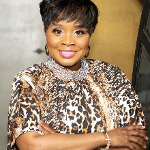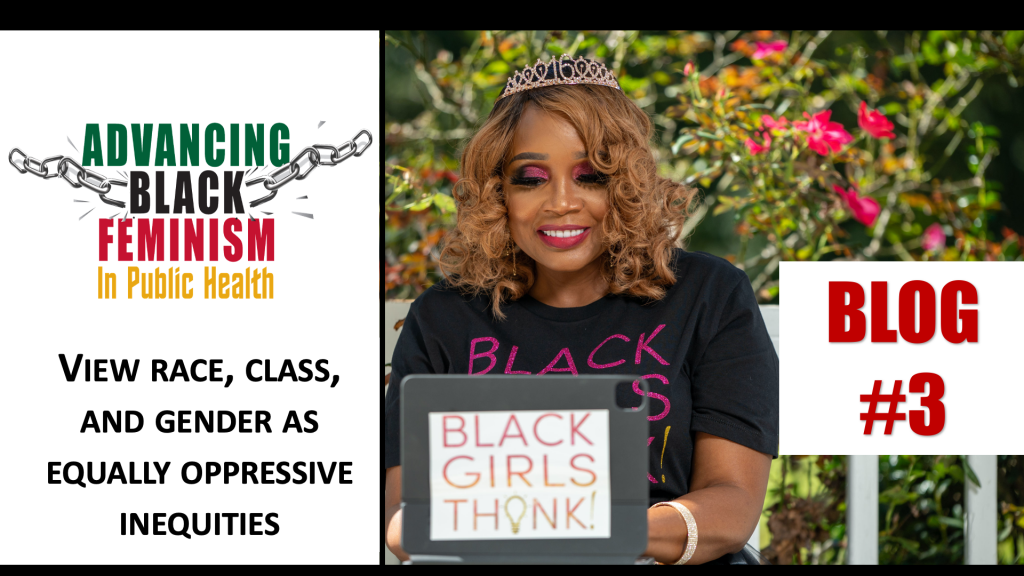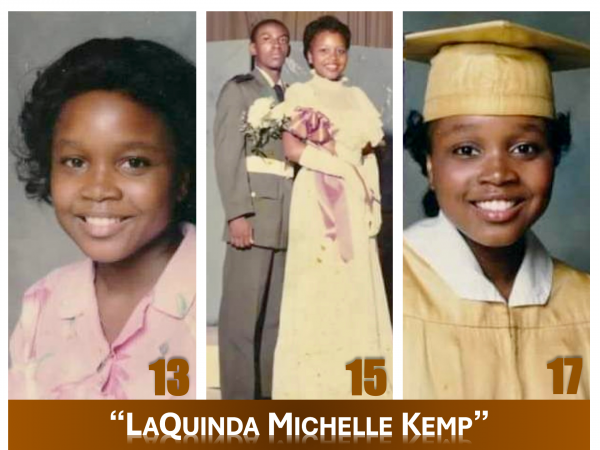

Welcome to my blog on “Advancing Black Feminism in Public Health.” My goal is to move black feminism from the margins to the center of public health by applying 10 key principles as legitimate and comprehensive frameworks for adequately addressing health threats and related social and structural determinants of health in the lives of black women and girls.
Dr. Quinn M. Gentry
In this blog on advancing black feminism in public health, I highlight principle no. 3 (of 10): View race, class, and gender as equally oppressive. Race, class, and gender identities serve as the foundation for studying health inequity from an intersectionality standpoint. Depending upon the health imperative, public health analysts and activists examine additional categories, including but not limited to, age, sexual orientation, and disabilities.
A black feminist standpoint in public health asserts that statistical studies of intersectionality in public health should include stories about the lives of those who experience health inequities due to race, class, gender, and other oppressions. This standpoint gave me the courage to share my struggles of compounded disadvantages; and simultaneously reinforced my keen sense of responsibility to advocate for vulnerable people facing a plethora of hardships that impede health and wellness.
I know first-hand the impact of the race, class, and gender disparities that poor black families face in their everyday lives.
Dr. Quinn, Intellectual Influencer Tweet
I remember the first time I scrutinized the seemingly cold and calculated statistical account of my daily struggles to survive the dominating grip of race, class, and gender inequality in my early life.
For clarity, my dissertation research led me to access U.S. Census Bureau data for my study’s catchment area. Out of curiosity, I checked the census tract level data for the community where I grew up in the 1980s and discovered a 79% poverty rate among a 97% African American population1. During the 1990s, which was the most recent census data available for my dissertation, the poverty rate had dropped to just under 40%2. As of 2019, this same neighborhood had a poverty rate of 20% among a 59% African American, 29% White, and 12% Other population. Let me be clear. Cutting the poverty rate from 79% to 20% over a 40-year period happened through uprooting and displacing the poor in exchange for gentrified community development projects, with relatively smaller efforts aimed at attacking concentrated poverty at its core via social, health, educational, and economic programs, and policies for the good of those born on “the other side” of the census tract.
Gazing at the first 18 years of my own race, class, and gender oppression depicted in the form of census tract data caused a lump in my throat, as a heaviness set in, that no matter how hard I worked and how much I tried to “keep hope alive”, I was stuck in this poverty-ridden census tract for at least 18 years through no fault of my own.
Tears of anger and sadness flowed because it dawned on me that these census statistics did not tell the full story of the suffering and struggles of many families trying to live “decent lives” and raise successful children even amidst dire poverty. For example, my teenage mother dropped out of the same high school I graduated from as Valedictorian. Despite an impressive 25-year work history, with minimum days off, she never made more than eight dollars an hour. In addition to witnessing my mother’s work ethic and entrepreneurial hustles as she reared 3 children, I was connected to extended family, church, school, and community-based social and health programs that contributed to my being able to reduce some of the harm associated with being a teenager in a community where crack-cocaine and HIV were making their “debut” in the early 1980s.
While I count myself among the “lucky ones”, my heart aches for all the young, gifted, black girls left behind. This drives my passion for integrating culturally appropriate practices into evidence-based health interventions to improve adolescent black girls’ health in the communities where they live, learn, and love. See below where I share a mini-case study of my G.E.M.S. program, which uses a mentoring and self-esteem building approach to improve outcomes for girls at greater risk for social and public health threats.
Black feminism in public health must create innovative interventions that disrupt generational damages caused by race, class, and gender oppression
Dr. Quinn, Intellectual Influencer Tweet
Last week, I kicked off my company’s 16-year anniversary with a “Sweet-16” themed party where I celebrated 16 sweet moments in business, tying each to a different “sweet.” Known for going all out in full character, I wore a Sweet 16 tiara and sash for the occasion.

I giggled as the event took me back to my 16-year-old self, where my most memorable moment was my first plane ride, along with six other Atlanta public school students, to New York, where we spent a week in Manhattan awaiting the arrival of about 40 other high school students from around the United States, who joined us as exchange students to Israel.
My 16-year-old walk down memory lane soon faded to thoughts about how living in a census track of concentrated poverty limited my educational pursuits, thereby impeding my capacity for upward mobility. The two white exchange students (with whom I enjoyed close friendships and found to be extremely pleasant and engaging during our studies abroad) were the benefactors of what I call “the normalization of white privilege”.
Let me explain what I mean by this. We all attended different schools in the same Atlanta public school system. However, because of their census tract zip code, their high schools (drawing from the same public funds as mine) granted them access to Arabic and Hebrew foreign language courses, while my only choice was French.

As I went on to pursue a career as a political intelligence officer focusing on Middle Eastern and South Asian countries, Arabic and Hebrew language proficiency mattered. In 1992, to even the playing field, I enrolled in an Arabic language class at the Middle East Institute in Washington, DC. and paid for classes that the two White, privileged students — in the same Atlanta public school system — received for free, courtesy of taxpayer funded public education.
Fast-forward to 1999, when I left the workforce to pursue a PhD in Sociology with a concentration in race and urban studies. What initially felt like success, after having earned — against seemingly insurmountable odds — a BA, MBA, and corporate and government mid-management professions, quickly diminished to “survivor’s guilt”.
This guilty conscious proliferated as I pulled health intervention files of high school cheerleaders, athletes, members of the academic top ten, and homecoming court queens, who had not been as “lucky” in navigating life on the rough side of the census tract. Having grown up in and around the study’s catchment area, it did not surprise me to discover that I knew some of the clients. However, I was not prepared for a client file I came across, belonging to a fellow honor student.
Perhaps, I would not have been as outraged if the file was that of a woman who, as a teenager, was already using the gateway drugs of alcohol and marijuana; or that of a girl who appeared to have no curfew and limited parental controls growing up. I would have expected the file to belong to one of the girls in my class who, at 16-years-old, flaunted the fact that they were dating men in their 20s and 30s. And just as I was about to justify my controlling images of women at risk, I realized that based on some of my own behaviors as an adolescent girl, this could have been my file.
I wept unconsolably as I reviewed the file for this young, gifted classmate whose clarinet solo received high praises during orchestra band competition, and whose beautiful soprano voice inspired the entire student body. What this former classmate and I have in common is that, as young, gifted, poor black girls in the arts and in academics, we both could have benefited exponentially from attending the Atlanta public high schools just across the census tract with the white privileged students: one had a performing arts program for my gifted classmate’s musical talents; and the other housed an international baccalaureate program that would have granted me access to a broader array of foreign languages and global career options.
Instead, we were marginalized and relegated to an underperforming school in the same school system where our white counterparts increased their competitive advantages under the premise of “normalized white privilege”. In denying us equal access to publicly funded educational endeavors, our school experience exposed us to higher rates of violence, drugs, trauma, and HIV/STDS. This is the real hurt, harm, and generational damage imbedded in the lived experience of young, gifted, poor black girls trapped behind race, class, and gender lines reinforced by a public education system wickedly disguised as the great equalizer.
There are various theoretical frameworks that are complementary to a race, class, and gender standpoint in public health. In this blog, I focus on those that encourage examining race, class, and gender with the intent to address social and structural determinants of health.
Combatting the intersection of race, class, and gender inequity in health prevention, promotion, and intervention is paramount. Public health researchers have made incredible strides towards specifying social and structural determinants of health. However, there remains much work to be done in public health to address the root causes of poor health conditions.
As a start, public health research projects examining intersectionality need to include black feminist thinkers in the analytic and interpretive phases to add context to study designs and statistically significant findings on multiple oppressions. At the same time, I challenge black feminists to move from “discussing” public health inequities to leading the charge towards “developing” more relevant public health initiatives. This includes “dismantling” policies and systems that perpetuate health inequity at the intersection of race, class, and gender.

One of my contributions to addressing multiple oppressions and behavioral risk factors faced by young, gifted, poor black girls is an evidence-informed program that includes features and incentives appealing to adolescents and their caregivers.
It was initially conceptualized as a self-esteem supplemental module for existing teen pregnancy and HIV/STD prevention programs. Over time, I added additional components and evidence-based modules, culminating in my signature adolescent girls’ program: G.E.M.S. (Girls Empowered and Motivated to Succeed).
Armed with Office on Women’s Health funding I have highlighted (to the right) key program features that participants, parents, and community partners ranked highly. My purpose in sharing about this program is to ignite public health content developers to think outside the “traditional intervention” box when designing programs for adolescent girls.
The G.E.M.S. program lifecycle is divided into three phases.
Phase 1 consists of the “standard modules” (1-5) and emphasizes rapport-building, mentoring, team building, trust, and self-esteem.
Phase 2 is a one-on-one session (Module 6) where participants discuss unique risk factors based on G.E.M.S. Communications Specialists’ observations during modules 1-5, as well as communications with caregivers and community liaisons. This format grants girls a safe space to disclose issues that may not have been appropriate in the group-settings.
Phase 3 includes “enhanced modules” (7-16) where evidence-informed protocols are used to discuss age-appropriate aspects of public health risks and protective factors for several health threats.

In dismantling the root causes of intersecting inequities, public health must play an enhanced role in moving from “analyzing” to “addressing” social and structural determinants of health. This may appear overly ambitious and perhaps unachievable for an individual public health advocate. I concur that it takes collective empowerment, activism, and social justice to effectively disrupt public health inequity, which I unpack in a later blog for principle 10 on advancing black feminism in public health.
However, I still believe that there are some differences you can make as an individual public heath activist. In fact, I imagine a world where, if you are researching or intervening with adolescent girls, then you have a moral obligation to find a way to immerse yourself into their lived experiences without compromising the integrity of the study and ethics governing adult-child interactions in general.
If time or personal decisions limit mentoring as the gold standard in effective youth engagement, consider other impactful ways of contributing to empowering girls, such as serving on girls-serving organizations’ boards, financial sponsorship, or opportunities for career exposure to public health professions.
Even if you only have a minute to share, and find yourself struggling with what to say or do with young, gifted, poor, black girls in your presence, I invite you to simply share an inspirational quote from women who, as young, gifted, poor, black girls defied the odds and inequities to become trailblazers in diverse fields, despite a census tract that had counted them out.
Be intentional about including inspiration in public health interventions to give hope to young, gifted, black, poor girls whose dreams have been deferred by dismal odds, but not altogether derailed.
Dr. Quinn, Intellectual Influencer Tweet
In my experiences, by the time I returned to my old community to mentor and intervene, I felt overwhelmed and frustrated that, in comparison to the suffering, public health initiatives pre-packaged in evidence-based toolkits seemed too little, too limited, and too late. However, just when I felt my efforts were not getting at the root cause of health inequities, I remembered that I may be influencing and inspiring the next “Laquinda Michelle Kemp” on her way to becoming “Dr. Quinn, Thinker, Writer, Educator, Motivator, Innovator”.

1U.S. Bureau of the Census. (1990). “Characteristics of the Population.” Summary Tape File 3. Washington, DC: U.S. Census Bureau.
2U.S. Census Bureau (2000). “Thematic Map Frames.” Summary File 1 (SF 1) and Summary File 3 (SF 3). Washington, DC: U.S. Census Bureau.
More from Dr. Quinn M. Gentry here.
HPHR.org was designed by ComputerAlly.com.
Visit HPHR’s publisher, the Boston Congress of Public Health (BCPH).
Email communications@bcph.org for more information.

Click below to make a tax-deductible donation supporting the educational initiatives of the Boston Congress of Public Health, publisher of HPHR Journal.![]()